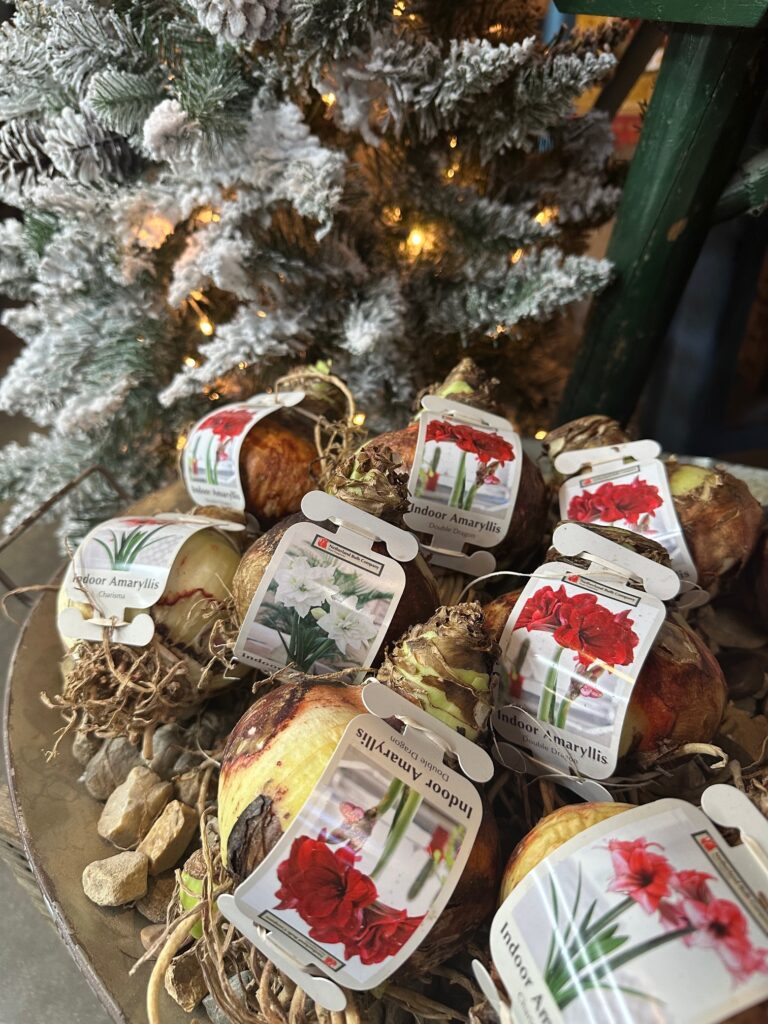How to Force an Amaryllis Bulbs

Around this time of year, we start thinking about holiday parties… which means we start thinking about decorating for those holiday parties! Poinsettias might be the most common holiday indoor plant, but don’t underestimate the beauty of an amaryllis in full bloom.
How to Force an Amaryllis Bulb
Place bulbs individually in 6 to 7 inch pots or place 3 bulbs together in a 10 to 12 inch container. Containers need to have drainage holes so excess water can drain out. Fill container halfway with moistened, good quality, well-draining potting mix. Our Good Earth brand Professional Potting Mix or our Ferti-Lome Ultimate Potting Mix are good options. Fill in around the bulb with additional soil, adjust the level so that the top one-third of the bulb is exposed. The final soil level should be about a half inch below the container rim. Place decorative stones or moss on the soil for a more finished look.
Amaryllis can also be grown in stones and water, as opposed to soil; just ‘plant’ them in 4 inches of stones after trimming any browned or dried roots, making sure to place stones around the base of the bulb. Add water to about an inch below the bulb base.

This is the first year we have had the wax and sweater covered bulbs; these require no watering! They make wonderful gifts for people who may not feel confident or have the time or inclination to care for a plant, along with everything else, during the busy holiday season. The waxed amaryllis bulbs are a dream to decorate with; since no container is required, you can easily place them in a shallow moss covered dish, surround with pine cones and Christmas baubles and have a simple but wonderful arrangement.
When to Force an Amaryllis Bulb
Amaryllis bulbs can take from 4 to 8 weeks from planting to bloom; have patience! Water sparingly until you see the tip of the first bud appear then water once a week. Be careful not to overwater your plants, as this could cause young roots or even the bulb to rot. A south facing window or sunroom is the ideal placement as the bulb begins to sprout. Rotate the pot frequently to prevent flower stalks from leaning towards the sun. If possible, when the first blooms appear, move the plant to a cooler location for a longer bloom period. Amaryllis flowers are large and can be heavy; taking may be necessary to keep to support the flower stalk and therefore avoid it toppling over.
How to Care for an Amaryllis After Blooming
Amaryllis make wonderful cut flowers; cut when the flower bud is starting to show color and is just about ready to open. Make a straight cut across the bottom of the stem, add preservative to the water if desired and change the water often. At 60-70 degrees Fahrenheit, flowers can last up to 10 days after cutting, however, they last longer if left on the plant.
After blooming, the bulb has exhausted its energy, however, it can be re-used if treated properly. To do this, remove the flower stalk after the blooms have faded but let the foliage remain on the plant. Keep the plant indoors, and continue to provide good light and adequate water until after the chance of frost, then move outdoors. Fertilize in the late spring and early summer, then allow the plant to go dormant as the summer progresses. As the plant is going dormant,the foliage will yellow and die back. Move the container to a cool dry place (around 55 degrees Fahrenheit). Cease watering when the plant is dormant, then begin watering again when you notice it is sprouting again. At that time, move the amaryllis to a warm, sunny location, then begin the process all over again! These are instructions for our area; in warmer climates, they can overwinter outdoors.
Many people treat these as winter annuals, similar to how poinsettias are treated, and start fresh each year.